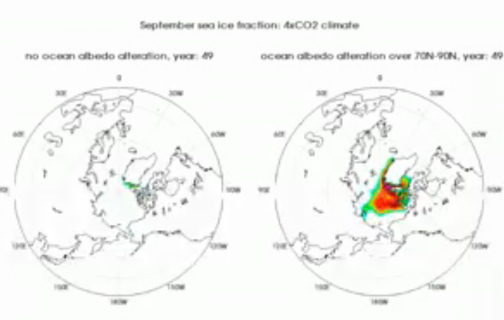
The Arctic Ocean is expected to transition into a seasonally ice-free state by mid-century, enhancing Arctic warming and leading to substantial ecological and socio-economic challenges across the Arctic region. It has been proposed that artificially increasing high latitude ocean albedo could restore sea ice, but the climate impacts of such a strategy have not been previously explored. Motivated by this, we investigate the impacts of idealized high latitude ocean albedo changes on Arctic sea ice restoration and climate. In our simulated 4xCO2 climate, imposing surface albedo alterations over the Arctic Ocean leads to partial sea ice recovery and a modest reduction in Arctic warming. With the most extreme ocean albedo changes, imposed over the area 70°–90°N, September sea ice cover stabilizes at ~40% of its preindustrial value (compared to ~3% without imposed albedo modifications). This is accompanied by an annual mean Arctic surface temperature decrease of ~2 °C but no substantial global mean temperature decrease. Imposed albedo changes and sea ice recovery alter climate outside the Arctic region too, affecting precipitation distribution over parts of the continental United States and Northeastern Pacific. For example, following sea ice recovery, wetter and milder winter conditions are present in the Southwest United States while the East Coast experiences cooling. We conclude that although ocean albedo alteration could lead to some sea ice recovery, it does not appear to be an effective way of offsetting the overall effects of CO2 induced global warming

